A Reckoning: Liverpool Biennial – Reviewed
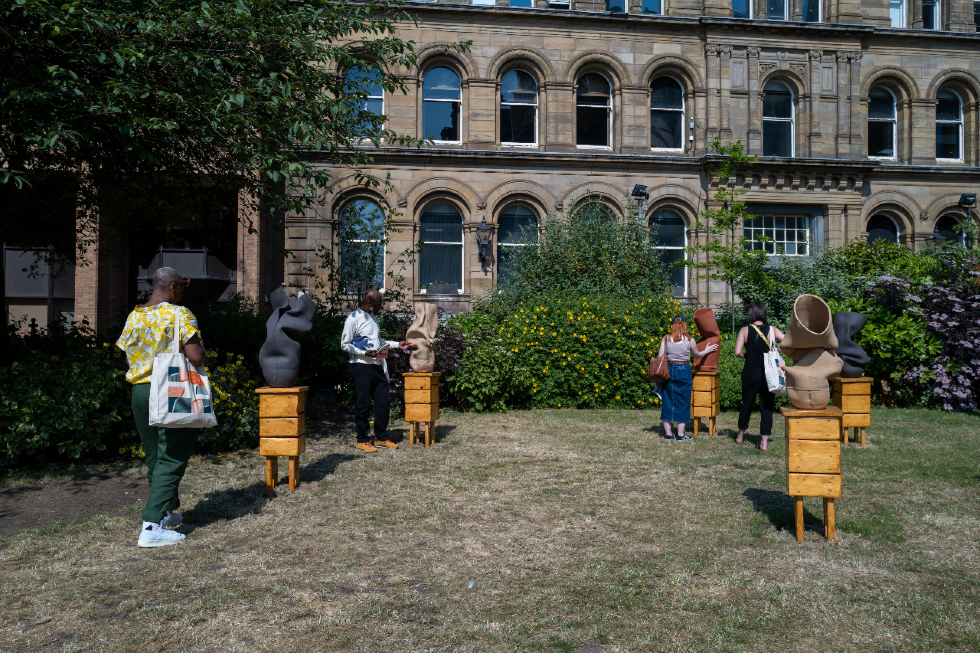
For the 12th edition of Liverpool Biennial, curator Khanyisile Mbongwa said she had been tasked with using art as a means to “move through the woundedness” of global and local traumas, both past and present. Amid these concerns, Mike Pinnington finds a Biennial that has rarely felt so in touch with the concerns of the city it calls home…
At a press conference marking the beginning of this year’s Liverpool Biennial, curator Khanyisile Mbongwa mentioned that, as preparation, she listened to people, venues, and institutions – to hear first-hand (rather than make assumptions about) how they saw themselves and their place in the city. As she writes in her guide notes: “I curate because I do not know.” It’s a logical and generous approach.
Such a starting point allows us all – residents and otherwise – the same clean slate, and to encounter the city through the lens of works clustered across it, with fresh eyes.
Mbongwa also noted, however, that on her visits in the weeks and months prior to the UK’s largest festival of contemporary art, she encountered a distinct lack of Black or Brown people. It will no doubt have given her pause and, perhaps, had a direct impact on the resulting biennial.
In many ways, Liverpool is still coming to terms with its prominent role in and the legacies of Empire. It is built on the back of slavery, and yet there are few officially sanctioned acknowledgements of this – or the attendant injustices and traumas, the iniquities. But one such example can be found in the courtyard of St. Nicholas’ Church. On a flagstone unveiled in 2020, there reads the epitaph:
Abell
An Enslaved African
And The First
Recorded Black Resident of the City
Buried in this Churchyard
1st October 1717
Nearby are sculptures by Ranti Bam (top). Collectively titled Ifa (taken from the Yoruba word meaning ‘to pull close’), in them can be seen the evidence of the artist’s touch – of Bam literally holding them close, caressing and thus warping their shape. These aren’t the epic works biennials are generally remembered for, but they provide quiet space for reflection, to take a breath and consider the imprint we leave on people and place, and vice versa.
This biennial is full of such subtleties and shrewd juxtapositions of work and venue – to the extent that, often, they feel as much like fateful serendipities as they do the result of astute curatorial decision-making. Perhaps one of the best uses of space in this regard is the Tobacco Warehouse. A building whose original purpose was to store rum and tobacco, it is emblematic of Liverpool’s position as second city of the Empire.
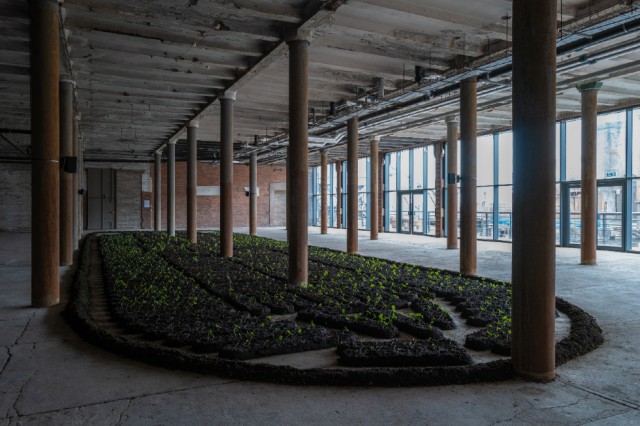
Now, though, it houses a group of artists exploring repair and healing. Among them, Binta Diaw. Her powerful work Chorus of Soil marks the plan of a ship, its surface area delineated by plots of soil. Standing in for the bodies of slaves it would have carried, it is a short leap to see them also as representative of graves. But there is life here, too. Sprouting from the soil are seeds; with attention and nurture, they will grow throughout the duration of the biennial. Eventually leaving the work, one can’t help but reflect on how these seeds – symbolizing the more than 130 Africans thrown overboard in the Zong Massacre – will receive much more care than slaves aboard ships such as this did.
Nearby, Australian Wiradjuri/Celtic artist Brook Andrew’s NGAAY (which in Wiradjuri means ‘to see’) presents in neon a combination of Irish, Scottish Gaelic, isiXhosa, Wiradjuri, Urdu, Mandarin and Welsh language translations, pointing to the many nationalities that have crossed and been witnessed by the River Mersey. Despite the scale, it’s a subtle work, open to interpretation. By contrast, over at the World Museum, Andrew’s darkly hypnotic film SMASH IT collages interviews with Australian Indigenous intellectuals, found footage and a booming soundtrack to starkly illustrate and critique colonial power. Its cacophony carries a panoply of messaging, not least regarding the dearth of choices available to the colonised.
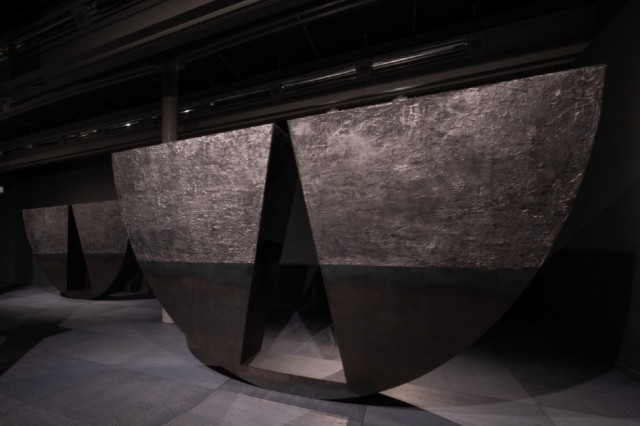
Negotiating Liverpool’s system of docks, you arrive at Tate Liverpool. There are, no doubt, ghosts here. Apt, then, that among other things, the works there seek to “explore ways to connect ancestral knowledge with the present.” On the ground floor, Torkwase Dyson’s Liquid a Place, suggests and puts the viewer into conversation with the shipping lanes that saw countless people lose their lives along with their liberty. But the imposing trio of works that evoke ship’s hulls and, therefore, the triangular trade of people and things, are substantial in more than just scale; they also present gateways, shelters, refuge and resistance. “Visit the water in your body,” reads text quoting Dyson, “think alongside it, imagine alongside it, refract alongside it, and refuse alongside it.”
Upstairs, Brazilian Isa do Rosário claims to be directly guided by conversations with deified ancestors called Orixás. These include “messages from the souls of Black people who were drowned in the Atlantic,” producing colourful banner-like textile works. Manifestations of the voices she hears, they speak of other realms, and the time and spaces between them. Their intent: nothing less than the delivery of lost souls. Quoting from art history, Lubaina Himid’s concise pair of paintings, meanwhile, subvert and skewer the canon, to insert and centralise Black figures where previously there would have been non (except, that is, in demeaning scenarios, or as peripheral figures).
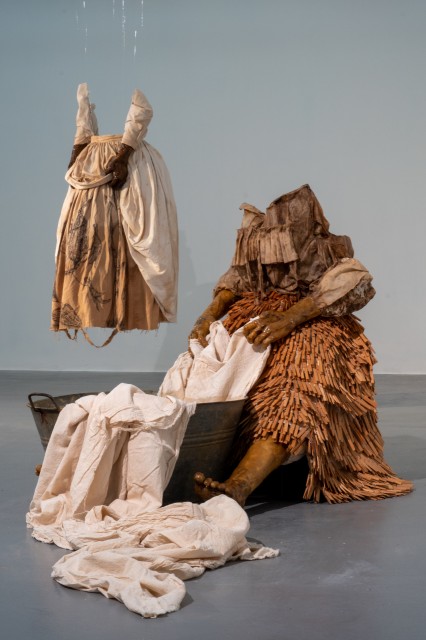
Similarly, Shannon Alonzo’s eerie, affecting sculptures address historical erasure and misrepresentation. Missing their heads, they begin and extend conversations, recuperating and adding texture to under- or misrepresented histories of Caribbean communities too often overlooked.
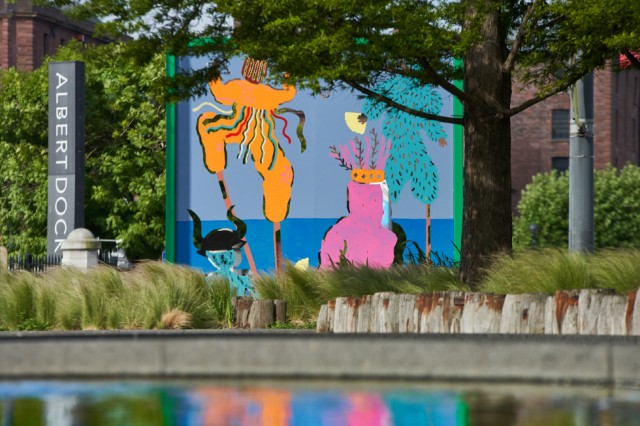
Crossing the threshold of Liverpool One into the city centre, you will encounter Rudy Loewe’s fittingly titled The Reckoning, which sees guardian spirits of Black Power confronting the historical legacies before them. The more one sees of this biennial, the more deeply it provokes consideration of crimes committed in the name of colonialism, and in the consolidation of its profiteers.
Inspired by the story of Bengal Lascars – sailors employed by the British East India Shipping Company – at Bluecoat, a survey of Raisa Kabir’s work engages directly with the building’s colonial beginnings. Titled Utterances: Our vessels for the stories unspoken. Subaqueous violence. Sea. Ocean… (2016-present), across textile, sound, video, and performance, the display speaks to the ways in which fabric, the movement of people, their skills and labour, all carry profound cultural meaning. They also, in some cases, could be confused with torture devices. Under the same roof you will find pockets of respite and real joy. In his film k’idéin yéi jeené (‘you’re doing such a good job’), Nicholas Galanin foregrounds hope. Specifically, through the love, nurture and positive reinforcement lavished on the next generation as a means to combat subjective, habitually negative narratives projected onto indigenous peoples. It is universal, touching, and beautiful in its simplicity.
Engaging with art and artists exploring troubling collective pasts – and presents – in such forensic detail can lead to fatigue, leaving one feeling both overwhelmed and impotent. But as with Galanin’s film, uMoya: The Sacred Return of Lost Things – while never shying away from the hardest of truths – offers more than pain. Khanyisile Mbongwa has said that she was tasked to “create and hold space for us to move through the woundedness.” In addressing so thoroughly Liverpool’s difficult history still reverberating in the now, she has had her hands full. With ‘care’, genuinely, very much a watchword of her curatorial practice, however, this is what she has striven to accomplish – and it’s palpable throughout. Through Mbongwa’s custodianship, Liverpool Biennial has rarely felt so in touch with the concerns of the city it calls home.
Mike Pinnington
Liverpool Biennial: uMoya: The Sacred Return of Lost Things continues until 17 September
Images: Ranti Bam, Ifas, 2023. Installation view at St Nicholas Church Gardens, Liverpool Biennial 2023. Photography by Mark McNulty. Courtesy Liverpool Biennial; Binta Diaw, Chorus of Soil, 2023. Liverpool Biennial 2023 at Tobacco Warehouse. Courtesy of Liverpool Biennial. Photography by Mark McNulty; Torkwase Dyson, ‘Liquid a Place’, 2021. Liverpool Biennial 2023 at Tate Liverpool. Courtesy of Liverpool Biennial. Photography by Mark McNulty; Shannon Alonzo, ‘Lowest Hanging Fruit’ and ‘Washerwoman’, 2018. Liverpool Biennial 2023 at Tate Liverpool. Courtesy of Liverpool Biennial. Photography by Mark McNulty; Rudy Loewe, The Reckoning, 2023. Installation view at Liverpool ONE, Liverpool Biennial 2023. Photography by Rob Battersby. Courtesy Liverpool Biennial





